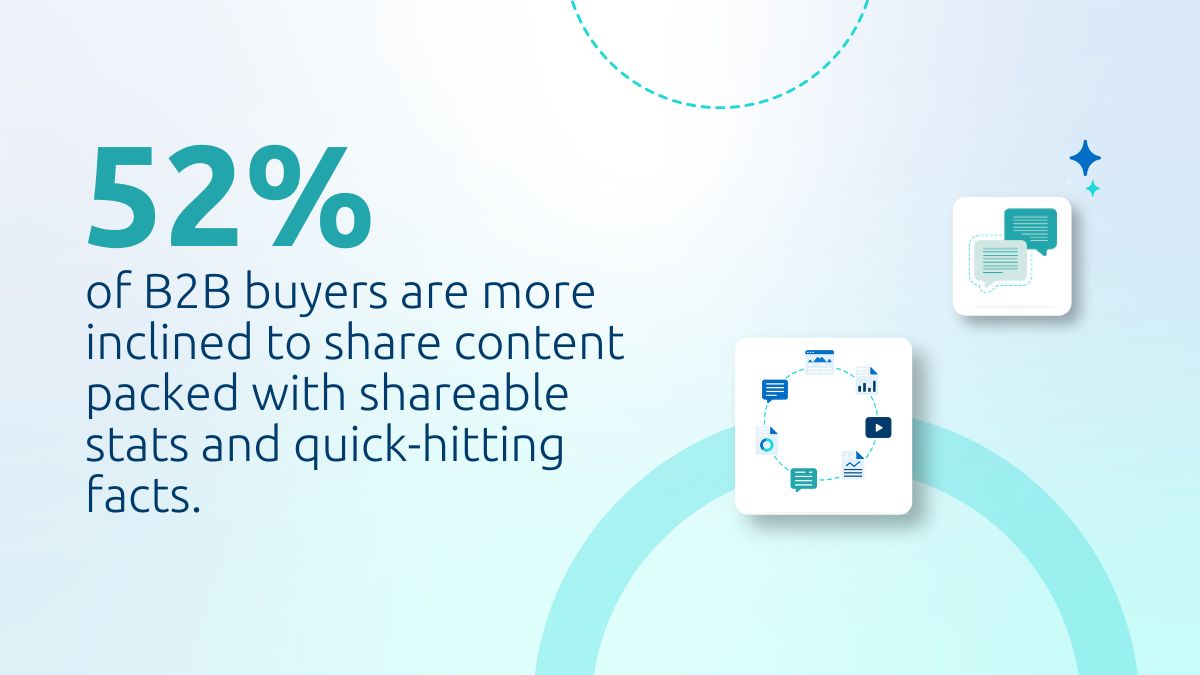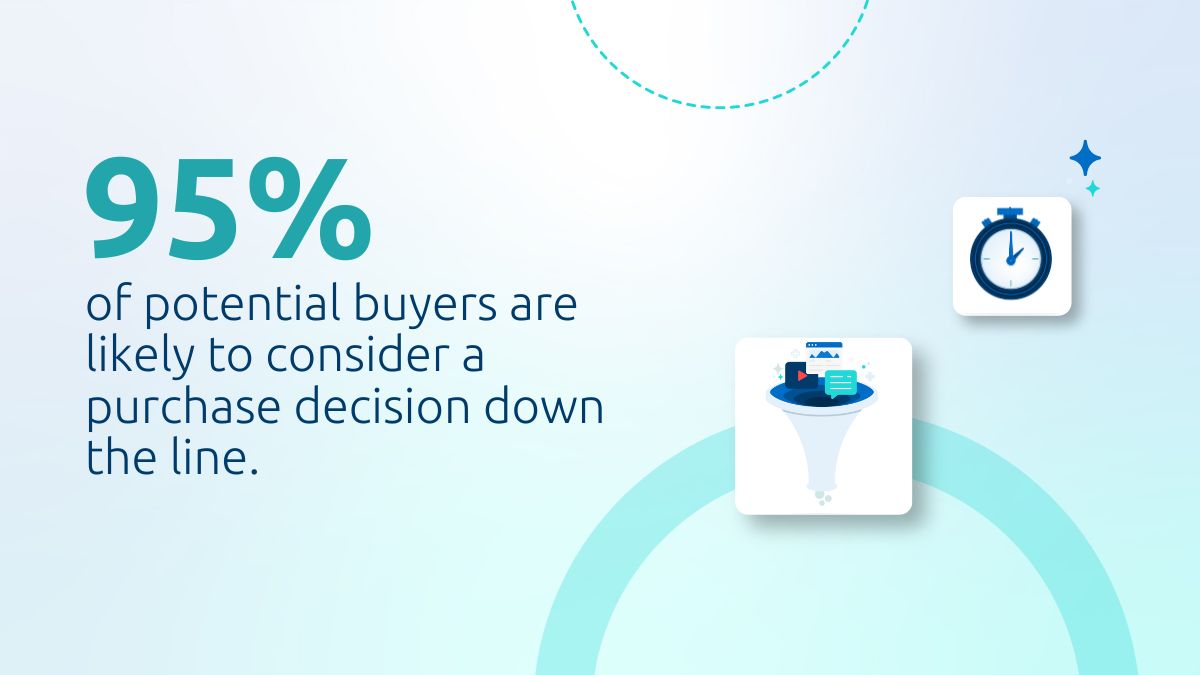A significant 71% of B2B buyers say they download and consume multiple assets to help with the decision-making process and an equal number said they share such content with their team members. This underscores the influence of sales collateral, ranging from traditional brochures to dynamic digital content like blogs and videos, in steering potential customers through their buying journey.
This guide shares the importance of sales collateral, who is responsible, and how to use it to seal the deal.
- What Is a Sales Collateral?
- Why Sales Collateral Matters for Every Business
- Which Sales Collateral Is the Most Effective?
- The Role of Sales Collateral in the Sales Process
- Types of Sales Collateral
- Tips to Develop Exceptional Sales Collateral
What Is a Sales Collateral?
Sales collateral includes everything from classic printed flyers and brochures to digital materials like blogs, eBooks, and videos. These resources are all about helping your sales team guide potential customers through their decision-making journey. The aim? To boost the chances of turning those prospects into actual customers.
These sales materials are not limited to external use; they also include internal resources like sales playbooks, battle cards, and sales plans, often known as sales enablement content. These internal tools equip sales teams with the knowledge and strategies to connect with customers.
Who Creates and Distributes Sales Collateral?
Collateral creation and distribution are a team effort. It involves sales and marketing teams, sales enablement, and subject-matter experts. The skills of graphic designers and videographers often enhance this collaboration.
Account executives, sales development reps, and business development reps turn to these resources throughout the sales cycle. They use these pieces of content to engage prospects.
The entire creation and distribution workflow closely aligns with content governance, emphasizing regular updates, maintaining brand consistency, and tracking collateral usage.
Why Sales Collateral Matters for Every Business
The days of gating information behind forms or holding back details until direct contact are fading. Now, 19% of buyers spend more time researching and 27% involve more people in their decisions, indicating a shift towards more autonomous decision-making. Sales collateral serves as a credible spokesperson in your absence.
Here’s why prioritizing sales collateral is essential for your business:
Increase Conversions
Sales collateral equips your sales team with materials to engage and guide potential customers. When the collateral aligns with the buyer’s journey, it can impact conversion rate.
Clarify Your Offerings
Developing product collateral presents prospects with a straightforward value proposition and benefits of your product or service.
Showcase Your Expertise
Thought leadership content positions you and your brand as a trusted authority. Prospects are more likely to select a product from a knowledgeable and reliable resource.
Supports the Buying Process
Buying can be complex, involving many decision-makers. Sales collateral acts as a guide, ensuring helpful information is available at each step and for each stakeholder.
Saves Time
Time is precious in sales and for all consumers. Easy-to-access information saves time. Instead of lengthy conversations, your team can share collateral that gets the message across quickly.
Which Sales Collateral Is the Most Effective?
The effectiveness of sales collateral depends on your brand identity, the type of product/service, the buyer’s journey stage, and the industry. However, most buyers tend to find quick-hitting, interactive assets most valuable, including infographics, webinars, and blogs.
Here are some other types of content that can make an impact:
- Long-form eBooks and guides: These resources can serve as comprehensive references, providing detailed advice and information in a digestible format.
- Industry reports: This content offers a platform for in-depth insights, thought leadership, and industry expertise, positioning your brand as a credible source that listens to 3rd party subject matter experts.
- Strategically timed video tutorials: Explainer videos can help describe product details and guide prospects toward more informed choices.
Important sales collateral metrics to watch include:
1. Reading Time
Monitoring the time prospects spend reading your collateral provides valuable engagement insights. Longer reading times indicate a deeper interest and grasp of the content, which can lead to higher conversion rates.
2. Meetings Booked
Track the number of meetings scheduled due to collateral engagement. It directly reflects the collateral’s success in driving prospects to take action and move further along the sales funnel.
3. Internal Shares
Do your buyers share collateral internally? This can be telling. Internal sharing metrics gauge the perceived value of the content and their confidence in using it to engage with the wider buying team. In fact, survey results show that 52% of B2B buyers are more inclined to share pieces of content packed with shareable stats and quick-hitting facts, while 43% prefer sharing ungated content, emphasizing the importance of data-rich and easily accessible materials.

Source: Demand Gen Report
The Role of Sales Collateral in the Sales Process
Sales collateral is necessary in a world where buyers are bombarded with options and information. It offers sales representatives versatile tools to deliver value, foster interest, and nurture meaningful conversations. Sales collateral is a bridge connecting your brand with your audience.
Customers have varied preferences. Some prefer phone conversations, others value in-person meetings, and many appreciate longer white papers or viewing pre-recorded product demos independently. A range of sales content caters to the various industries, roles, and demographics you serve.
Download Resource: The All-In-One Sales Content Management Toolkit
How Has Sales Collateral Changed?
It wasn’t long ago that sales collateral included printed materials like brochures, catalogs, and datasheets. Sales teams relied on these as tools of the trade. The arrival of technology and the internet transformed this approach, enabling businesses to reach a broader audience.
With digitization came the expansion of content marketing and inbound sales. Nowadays, businesses create interactive and visually appealing content like infographics, online calculators, and eBooks. These are used to capture and engage potential customers early in their buying journey.
Overall, the history of sales collateral reflects the ongoing digital sales shift and self-serve, content-driven approaches, constantly adapting to changing consumer preferences.
Types of Sales Collateral
Different stages of the buyer’s journey demands a specific collateral. For awareness, educational blogs and eBooks build trust. During consideration, case studies and datasheets make a difference. In the decision stage, collateral focuses on pricing and scope. Post-sale, knowledge bases, and training materials support retention and advocacy.
What collateral works well at each stage of the buyer’s journey?
Awareness Stage
During the awareness stage, prospects are just discovering their challenges. Educational collateral position your brand as a trusted source.
Research indicates an opportunity for salespeople: only 5% of potential buyers are currently in-market, but the remaining 95% are likely to consider a purchase decision in the future. Therefore, providing educational and informative content at this top-of-funnel stage brings your brand front and center. It ensures that when potential buyers are ready to decide, your organization is on their shortlist, having already established industry authority.

Source: Demand Gen Report
The more effective you are at building awareness, the greater the likelihood of becoming a ‘household name.’
- Blogs: Craft informative articles that raise awareness about industry trends and issues, as well as tips and best practices.
- Whitepapers: Offer in-depth reports providing valuable insights on specific topics.
- eBooks: Create comprehensive, visually appealing guides that educate prospective customers on relevant subjects.
- Landing pages: Design targeted web pages designed to capture initial interest.
- Webinars: Host interactive webinars that cover industry trends and educational topics.
Consideration Stage
During the consideration stage, prospects evaluate various solutions. They have identified a problem within their business and are considering how to address it. At this stage, they desire a deeper understanding of the benefits and costs and may seek to connect with other customers who have experienced similar challenges.
They look to resources that validate their thoughts to help them make a final decision.
- Case studies: Present real-world success stories showcasing how your solution benefits others.
- Product brochures: Provide detailed documents highlighting product features and benefits.
- Industry analyst research reports: Offer data-driven analysis that assists in informed decision-making.
- Buyer’s guide: Supply comprehensive product details that help prospects evaluate their options.
- Sales scripts and email templates: Create structured communications, including sales pitches and email scripts for engaging prospects.
Decision Stage
In the decision stage, prospects are ready to make a definitive choice. They require an understanding of the implications of implementation, ongoing support costs, and will engage in price negotiation. They also may need to convince the remaining decision-makers who control the budget.
Collateral that assists in finalizing pricing, clarifies work parameters, and even offers proof of concept trials plays a role in achieving your sales strategies and closing deals.
- User reviews: Point buyers to current user feedback.
- Pricing guides: Present transparent information about costs and packages.
- Statement of work (SOW): Provide detailed documentation outlining project scope and deliverables.
- Closing sales presentations: Prepare customized PowerPoint presentations or pitches tailored to prospects’ specific needs and proposed solutions and costs.
- Proposals: Submit formal documents outlining proposed solutions and terms.
Retention and Advocacy Stage
Once the deal is sealed, it’s time to roll out the welcome mat. The goal is to keep customers happy and turn them into fans that recommend your solution. Examples of sales collateral for retention and advocacy include:
- FAQ and knowledge base: Build a comprehensive guide for ongoing support, with clear, detailed answers to common queries.
- Product manual: Document in-depth information about the product, features, and usage.
- Product training materials: Compile informative and user-friendly content offering practical tips and product advice for new customers.
- Use cases: Showcase examples of how various organizations and industries utilize the product.
- Customer loyalty programs: Detail incentives for customers to remain engaged and to advocate for your brand. It outlines the benefits and how customers can participate in these programs.
- User groups: Establish supporting collateral guides on how to join these groups and the value users will gain from the community and shared learning.
- Post-sale activity guide: Construct a roadmap for all post-sale interactions. It outlines the roles of different departments – from support to accounting to professional services – ensuring a cohesive approach to customer satisfaction and engagement.
Tips to Develop Exceptional Sales Collateral
To create effective sales collateral, you need to understand what your target audience likes, use old content in new ways, adhere to your brand, use sales enablement tools for oversight, and make sure it looks good. Here are some tips to get started:
Focus on What Your Audience Needs and Wants
Studying your audience and buyer personas is the best way to create sales collateral that works. Tailor your content to address their pain points, and priorities. Market research will help craft messages that resonate with them, ensuring your collateral is informative and relatable.
Recycle and Repurpose Your Sales and Marketing Materials
Get the most out of your existing content by giving it a new life in different forms. For example, you can transform case studies into bite-sized testimonials to share in social media posts. You may also convert exhaustive whitepapers into a series of short, digestible blog posts.
This approach saves time and resources and extends your content’s reach across different channels and audiences.
Keep Everything On-brand
Building trust and brand recognition hinges on consistency. It’s important to make sure all your sales collateral reflects your brand’s style and voice. This includes using uniform colors, fonts, logos, and messaging across all materials. On-brand collateral reinforces your professional image and makes your content instantly recognizable.
Leverage Your Sales Enablement Tools
Use CRM and sales enablement tools to manage, distribute, and measure the performance of your collateral. These tools make content organization easy, ensuring your sales team has quick access to the materials they need. They also offer insights into which content is most valuable to your audience.
Invest in Original Design
Investing in high-quality, original design can elevate the impact of your sales collateral. A visually appealing layout captures buyer attention. It enhances the user experience, making your content more interesting and memorable.
Empower Your Team with the Best Sales Collateral
Think about your last big purchase. What did you do first? If you’re like most of us, you probably started with some online research – diving into product specs, checking out what others had to say, and even getting inspired by a few success stories. That’s the power of sales collateral. It’s guiding buyers through buying decisions. Businesses that want to succeed must deliver content that’s compelling and easy to find.
Enter Highspot. Highspot offers a solution where you can effortlessly manage, categorize, distribute, assess, and centralize your sales and marketing collateral all within one sales enablement platform. This approach allows sales reps to customize and share content seamlessly. Simultaneously, marketers gain access to analytics on both internal usage and external engagement – enabling continuous improvement. Schedule a demo of Highspot today.


